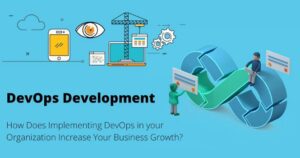The customer’s business world and the choices they have about deployment are the primary factors that influence the deployment of mobile apps to a production environment. The following list provides an overview of some of the most common services used for cloud-based implementations. For operations that are not based in the cloud, the apps may be hosted on local servers that can be situated either on the company’s premises or at a facility that is co-hosted.
The ecosystem for the creation of mobile apps has recently undergone a transformation into a fast-paced and constantly shifting one. While DevOps Development Company teams race from one release to the next, organizations are always faced with the risk that other teams may not be in sync with one another. DevOps is a proven and established approach that aims to bring together different teams that are engaged in the application development lifecycle so that they may work in concert with one another. It is the methodology that regulates the Agile project implementation.
DevOps gives an Understanding of the Crucial DevOps Patterns
Extending the development phase into production, incorporating feedback from the production phase into the development phase, embedding the development phase into the IT operations phase, and finally embedding the IT operations phase into the development phase are the four primary categories of DevOps patterns. Such patterns are helpful since they guarantee that both the code and the infrastructure are ready for production. In addition, it assists in the production of user stories that could be reused for IT operations and even specifies the non-functional needs that may be used throughout the procedure.
What does it mean to manage the application’s performance using DevOps?
The software life cycle does not completely conclude until the software has been built and placed in production. This step is necessary to ensure that the program that has been deployed is successfully operational.
Therefore, DevOps application development Company determines how to monitor the production site once the program has been deployed. Find the problem before the consumer does so that you may avoid any potential complaints. As a result, APM is aware of the ways in which customers make use of our software and is actively engaged in the process of gaining an understanding of the needs that customers have in order to guarantee that we create the appropriate things for those customers. Once the program has been successfully delivered to the production environment via the DevOps delivery pipeline, it is the obligation to guarantee that it functions as intended in the testing situation.
DevOps Application gives you the ability to:
1. Provide insight into transactions and the value of transactions from beginning to finish, including visibility into back-end systems and mainframes
2. Acquire an understanding of the main business KPIs of specific business processes that are unsuccessful, such as order backlog or dollars affected
3. Be sure you keep an eye on the experience that end-users have with applications and services by utilizing both synthetic and real-user performance monitoring
4. Be responsible for managing both the infrastructure and the service levels depending on the business
5. Perform problem triage and investigate the underlying causes of issues in sophisticated and composite systems running in a variety of environments, including J2EE,.NET, SAP, Oracle, Siebel, service-oriented architecture (SOA), and others
6. Using guided procedures that allow correct problem assignment responsibilities to the right subject-matter expert, locate and address application performance issues as rapidly as possible.
7. Integrate and correlate application performance data with network performance indicators in order to quickly identify issues and conduct incident management properly
8. Work in tandem with the application development teams to find and implement efficient solutions to application and transaction problems.
9. Decrease the meantime to fix the most important of your company’s transactions
10. Provide role-based application views that dynamically integrate the experience of the end-user with the performance of the system by using a unified model.
11. Be sure to monitor the performance of programs once they have been moved to the cloud or a virtual environment.
12. View application performance alerts anytime, anyplace, and on any mobile device in a very simple and straightforward manner
The first step toward achieving success with DevOps application development Company is to provide purpose-built gear that not only drives high levels of automation but also ensures the product’s quality. They propose using an open-first strategy rather than limiting your possibilities by just integrating certain components one at a time. Implementing DevOps for enterprise may improve the overall performance of your company by improving your software development process and producing value for both your employees and your customers. With DevOps application development Company you can improve the collaboration between the operations team and the developers in a company. Businesses have the ability to quickly increase the productivity of their developers.








